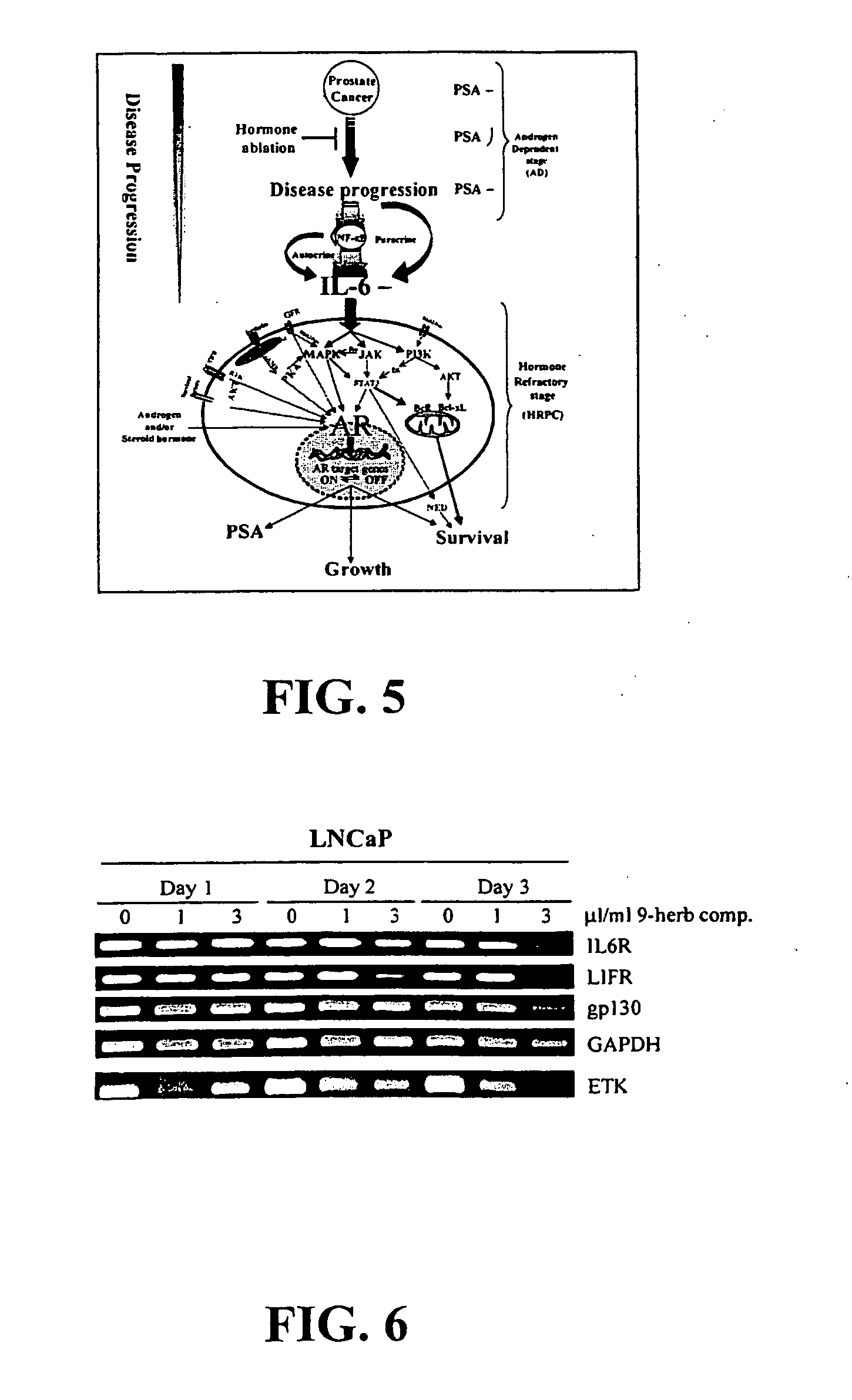Compositions and methods for prostate and kidney health and disorders, an herbal preparation
a technology for kidney health and disorders, applied in the field of herbal compositions and methods, can solve the problems of over-all imbalance in the organism as a whole, reducing the ability of blood vessels to filter toxins, and high blood pressure can damage the nephron, so as to reduce toxicity
- Summary
- Abstract
- Description
- Claims
- Application Information
AI Technical Summary
Benefits of technology
Problems solved by technology
Method used
Image
Examples
example 1
[0136] LNCaP Studies. Effects of ethanol extracts of the 9-herb composition on proliferation of androgen-dependent LNCaP cells FIG. 1 illustrates the inhibition of LNCaP cell proliferation by the addition of varying concentrations of the representative composition. A concentration of 1 μl / mL of extract was sufficient to cause a 30% reduction in cell growth after cells were cultured in the presence of such extract for three days. Increasing the concentration of the extract resulted in a significant reduction in cell proliferation. Addition of ethanol extracts of the 9-herb composition resulted in a dose- and time-dependent reduction in cell growth; whereas control cells proliferated effectively following a slight lag on day 1, cells treated with the 9-herb composition showed little growth. Cells treated with the higher dose of the 9-herb composition had less cells on day 3 compared to day 1. These results suggest that the 9-herb composition elicited both cytostatic (low dose, solid s...
example 2
[0137] Inhibition of LNCaP Cell Colony Formation. To further confirm the growth-suppressive property of the 9-herb composition, other growth characteristics of tumor cells in culture were utilized, namely, cell density, tumor cells are typically unrestricted by contact inhibition and will continue to grow and form foci of clustered cell colonies unlike normal cells. This assay is known as a colony formation assay that can be easily performed by fixing and staining cells followed by a period of time in culture. The number of colonies can be quantitated and compared to control conditions. FIG. 2 shows that the clonogenicity of LNCaP cells is extremely sensitive to the addition of extracts of the 9-herb composition. A concentration of 1 μl / ml significantly inhibited colony formation of LNCaP cells.
example 3
[0138] Cell Cycle Effects. FIG. 3 shows effects of extracts of the 9-herb composition on cell cycle phase distribution proliferation in androgen-dependent LNCaP cells.
[0139] To further test the ability of ethanolic extracts of the 9-herb composition to affect properties of tumor cells in culture, flow cytometry was employed to measure cell cycle distribution. This is an automated technique that quantifies the relative number of cells in G0+G1, S, or G2+M phases of the cell cycle. Cultured cells are suspended as single cells, and stained with a fluorescent DNA dye. The sample of cells than flows past a light source and a detector records the relative DNA content (measured by the amount of fluorescent signal per cell). This graph is a reflection of the relative percents of cells in each phase after the various treatments. FIG. 3 shows the DNA content of LNCaP cells cultured in the presence of the 9-herb composition extracts for 72 hours. This reflects the DNA content of the cancer ce...
PUM
| Property | Measurement | Unit |
|---|---|---|
| median survival time | aaaaa | aaaaa |
| survival time | aaaaa | aaaaa |
| survival time | aaaaa | aaaaa |
Abstract
Description
Claims
Application Information
 Login to View More
Login to View More - R&D
- Intellectual Property
- Life Sciences
- Materials
- Tech Scout
- Unparalleled Data Quality
- Higher Quality Content
- 60% Fewer Hallucinations
Browse by: Latest US Patents, China's latest patents, Technical Efficacy Thesaurus, Application Domain, Technology Topic, Popular Technical Reports.
© 2025 PatSnap. All rights reserved.Legal|Privacy policy|Modern Slavery Act Transparency Statement|Sitemap|About US| Contact US: help@patsnap.com



